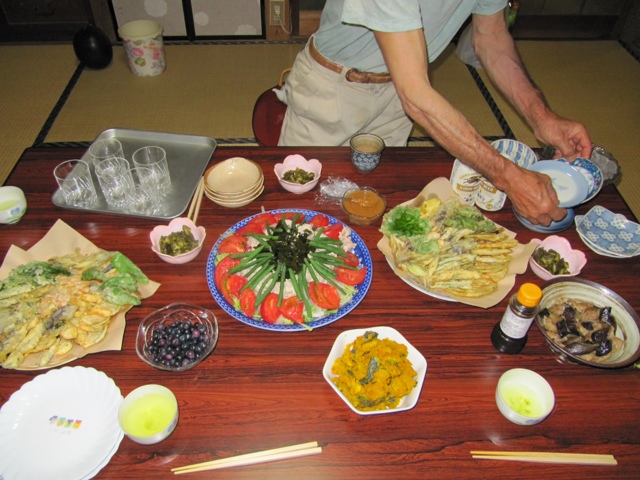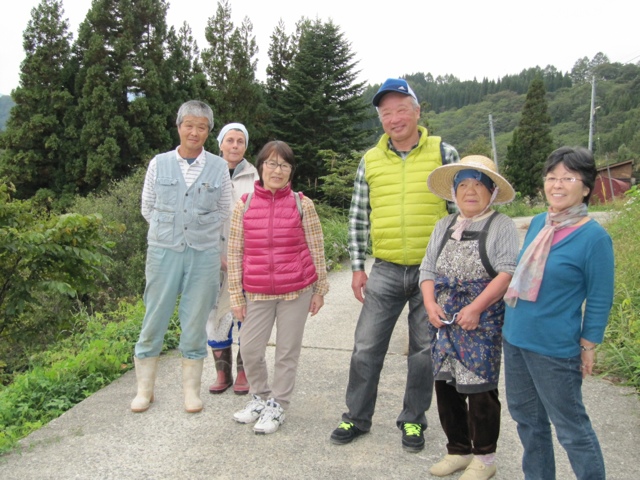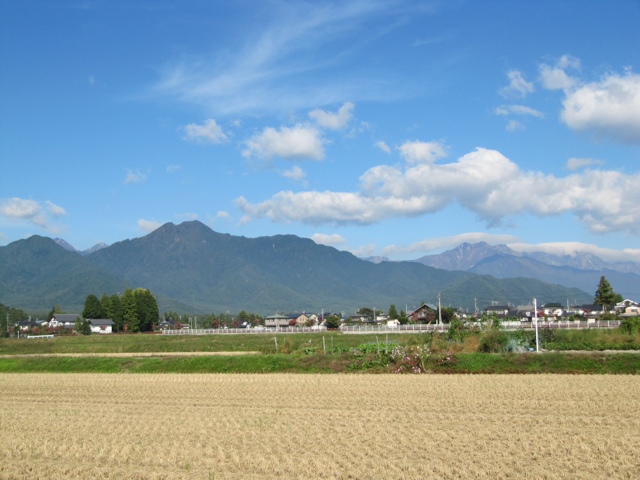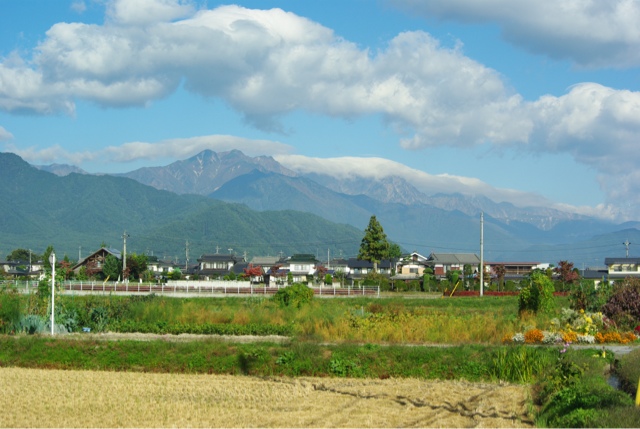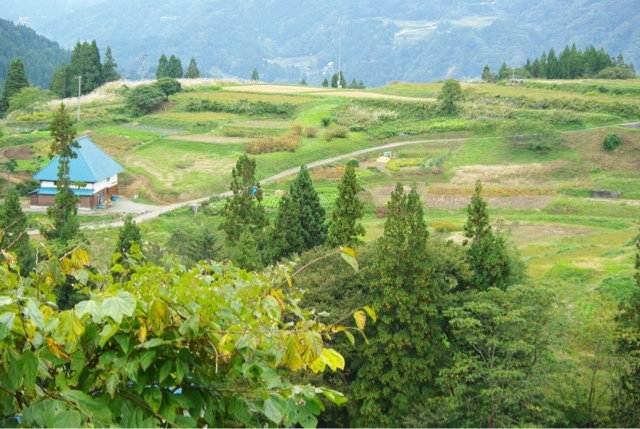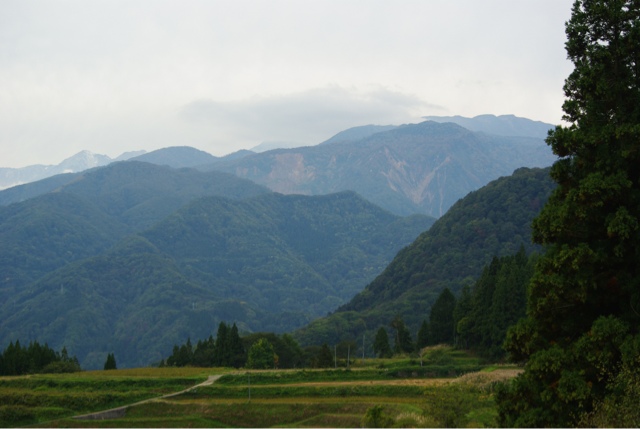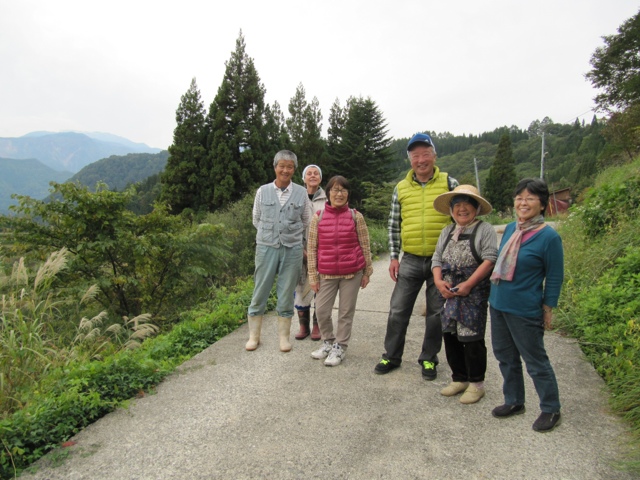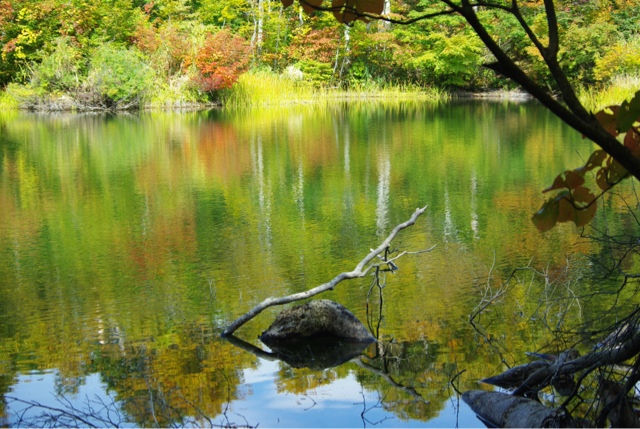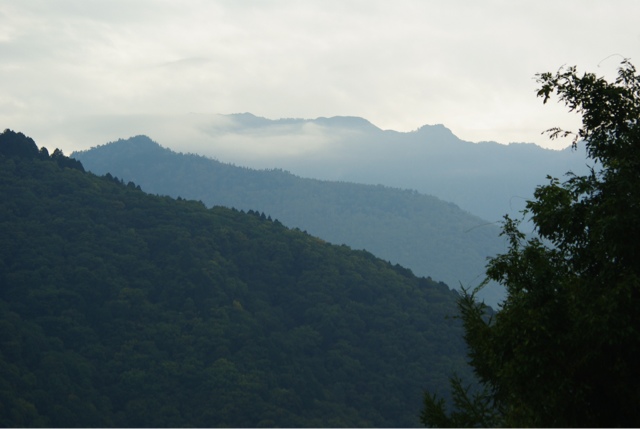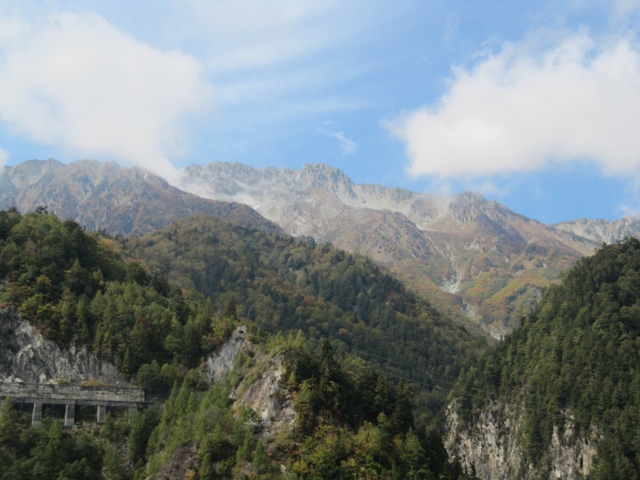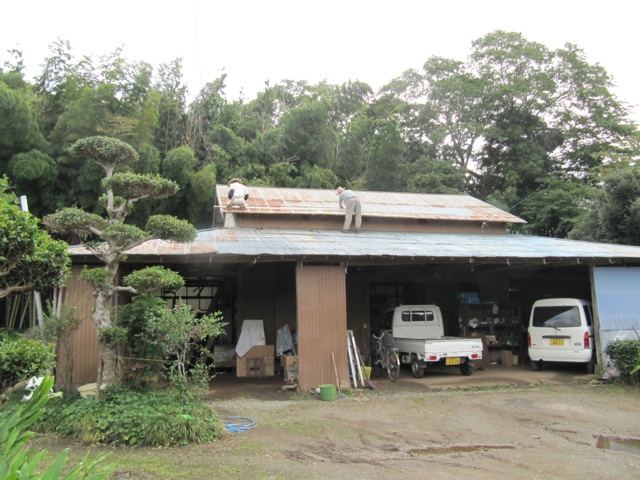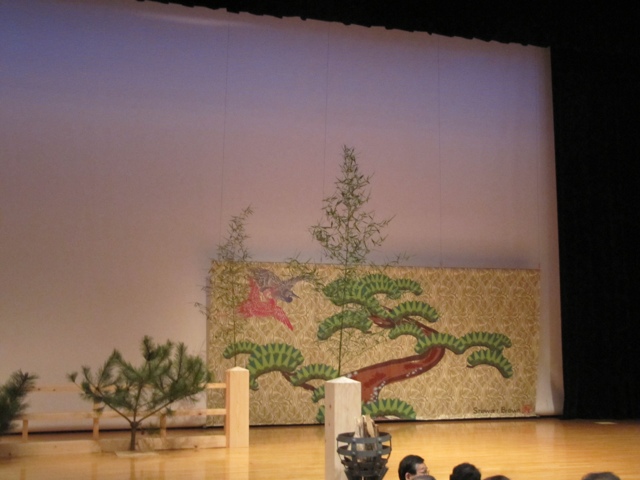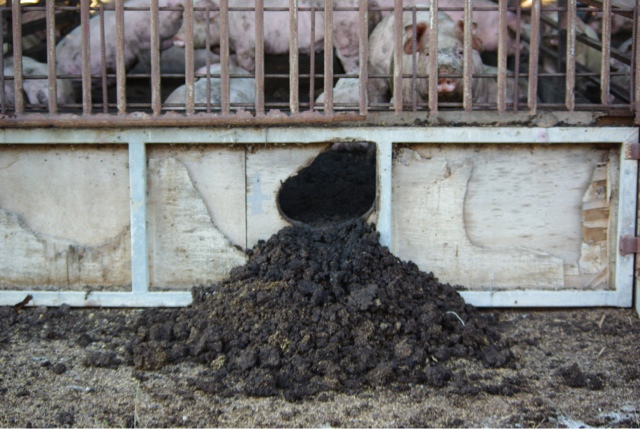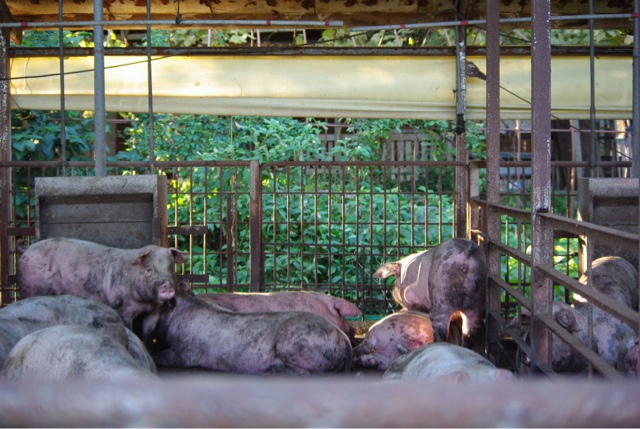Ibaraki-ken is second only to Hokkaido with respect to farming activity. And we are beginning to believe that they can grow almost anything here. Summer may well be the slow season as it tends to be very hot. Eggplant and cucumbers appear to like the heat.
Foods collected in the wild or growing wild include "takenoko" or bamboo shoots, "mioga" or the inner shoot of a weed, "nanohana" or canola flowers and shoots, asparagus (semi-wild), "fuki" a hollow stemmed wild plant, "shiso" leaves, jelly made from roots of kudzu vine and other wild plants we have forgotten the names of.
From the trees growing here we have eaten "kuri" or Japanese chestnuts, "sudachi" a mild lime like citrus fruit, blueberries, "kaki" or persimmon, "ume" or green plums. Passion fruit is a bit of a novelty and the plant only produced a single fruit. Loquat or "biwa" may or may not be grown in Ibaraki. I have eaten "gumi" a wild cherry like fruit we spotted in Hokkaido. We will probably not be around when the oranges and "mikan" or Japanese oranges are ready.
"Ocha" or green tea bushes are growing on the property.
From the fields we have eaten "horenso" or spinach, "negi" or the inner shoots of a large green onion, "ninjin" or carrots, a few sugar snap peas, a few green beans, "jagaimo" or potatoes, "tamanegi" or field onions, "satoimo" or taro root, "renkon" or water lotus, of course "gohan" or cooked rice, "kiuri" or Japanese cucumbers, "nasu" or eggplant, "piman" or sweet peppers, some sweet corn, peanuts, "daikon" or large Japanese radish, smaller radishes, lettuce, "satsumaimo" or sweet potatoes (hopefully ready soon), tomatoes, "goya" a bitter rough cucumber like fruit on vines (originally from Okinawa), "hakusai" or Japanese cabbage, broccoli, cabbage, "suika" or watermelon, "kabocha" or pumpkin like squash, "shoga" or fresh ginger (very potent), "uri" or cucumber like eaten as an instant pickle when green or as a melon when ripe, "edamame" or green soybeans, "soramame" or giant beans "okura" or okra (somehow was never harvested), "gobo" or burdock root, basil, chrysanthemum flowers, azuki beans are grown here. It is too warm for apples which we saw many of in Hirosaki in Aomori-ken as well as near Omachi in Nagano-ken.
When I mention the possibility of a pig roast, I distinctly get the feeling that I dare not! The "ika" or squid drying on the 'spin dryer' is a favourite of mine as "sashimi" that is raw fish or barbecued, but Ibaraki is not known for "ika". Hakodate on Hokkaido is the place to find fresh "ika" early in the morning.
We get a lot of food from our hosts the Okano's and other neighbours in Komatsuka, but we still like to have extras such as bread, eggs, yoghurt and coffee. Sometimes it appears as though the Okano's are 95% self sufficient.
Click on link to see photographs on Picasa.
Ibaraki Foods
Thursday 25 October 2012
Tuesday 23 October 2012
Imonikai at Akigawakeikoku
It is a tradition especially in Yayoi's home prefecture of Yamagata which begins in high school, where in autumn people gather at a riverside to enjoy the taste of "imo" a potato like tuber. Yayoi's former classmate Kakima-kun invited us to such a party for people living in the Tokyo area who originated in Yamagata prefecture in the area Yayoi was brought up in. On October 21, 2012 we went to Akigawakeikoku and walked down to the river area where many groups had shelters on the rocky river beach. Apparently the equipment could be rented from a shop on the upper river bank. Our large group was split into about eight sub groups based on region of origin each had a blue tarp, two tables and a tripod and barrel fire pit with wood supplied.
A large cooking pot was filled with broth, mushrooms, Yonezawa beef, eggplant and of course "imo" all of which was supplied from Yamagata-ken. Later some people near the administrative shelters began pounding a special cooked rice to make "mochi", a very sticky chewy rice.
We ate the soup (three helpings in my case) and later we had the "mochi" with either azuki bean paste on it or edamame paste.
It was a very warm sunny day at the beach and I managed to "fry" the right side of my face. Yayoi met former classmates and had a nice chat with a good friend of her brother Tsutomu in Ome.
I sat on the river bank and threw pebbles into the water. A little boy attempted a conversation with me and had quite a disgusted look on his face when he realized he was 'losing me'. Anyway his little sister came and sat down near me, I fished a plastic shovel out of the water for her and we became best of friends, although she was a little camera shy.
Click on link to see photographs on Picasa.
Imonikai Party
A large cooking pot was filled with broth, mushrooms, Yonezawa beef, eggplant and of course "imo" all of which was supplied from Yamagata-ken. Later some people near the administrative shelters began pounding a special cooked rice to make "mochi", a very sticky chewy rice.
We ate the soup (three helpings in my case) and later we had the "mochi" with either azuki bean paste on it or edamame paste.
It was a very warm sunny day at the beach and I managed to "fry" the right side of my face. Yayoi met former classmates and had a nice chat with a good friend of her brother Tsutomu in Ome.
I sat on the river bank and threw pebbles into the water. A little boy attempted a conversation with me and had quite a disgusted look on his face when he realized he was 'losing me'. Anyway his little sister came and sat down near me, I fished a plastic shovel out of the water for her and we became best of friends, although she was a little camera shy.
Click on link to see photographs on Picasa.
Imonikai Party
Thursday 18 October 2012
Ryoji and Debra
Ryoji-san and Debra-san have been married for forty years and appear to be a perfect Japanese couple. But she is not Japanese. So how did they meet?
Ryoji-san grew up in Otari, but although being a smart student was unable to go to university due to family finances. In Nagano there was a agricultural school run by a Christian organization. They offered scholarships to bright students and Ryoji-san was chosen to go. He excelled and was eventually chosen to go to school in Florida, U.S.A. At some point he will have gone to the church supporting these schools in Florida and here he met Debra-san.
Debra-san was the oldest child of eight and her father's job situation was somewhat migratory. At some point she also went to the church supporting Ryoji-san's schools and when they met, there must have been a few sparks.
Ryoji-san told Debra-san that they had a dairy cow in Nagano. Debra-san interpreted this to mean that Ryoji-san's family had a substantial daIry farm. Anyway she must have been one gutsy young lady of a mere 17 years when she married Ryoji-san age 25 in Florida. Later she emigrated from the U.S.A. and the Florida flatlands to live in the highlands of Japan. The dairy farm turned out to be one milking cow that lived in the house with the family, probably in an attached building. Seeing her in Otari it is obvious she has become well integrated into rural Japanese society.
In Otari their next door neighbour's were Norio-san and Kuniko-san for eight years.
Ryoji-san grew up in Otari, but although being a smart student was unable to go to university due to family finances. In Nagano there was a agricultural school run by a Christian organization. They offered scholarships to bright students and Ryoji-san was chosen to go. He excelled and was eventually chosen to go to school in Florida, U.S.A. At some point he will have gone to the church supporting these schools in Florida and here he met Debra-san.
Debra-san was the oldest child of eight and her father's job situation was somewhat migratory. At some point she also went to the church supporting Ryoji-san's schools and when they met, there must have been a few sparks.
Ryoji-san told Debra-san that they had a dairy cow in Nagano. Debra-san interpreted this to mean that Ryoji-san's family had a substantial daIry farm. Anyway she must have been one gutsy young lady of a mere 17 years when she married Ryoji-san age 25 in Florida. Later she emigrated from the U.S.A. and the Florida flatlands to live in the highlands of Japan. The dairy farm turned out to be one milking cow that lived in the house with the family, probably in an attached building. Seeing her in Otari it is obvious she has become well integrated into rural Japanese society.
In Otari their next door neighbour's were Norio-san and Kuniko-san for eight years.
Norio and Kuniko
Norio-san and Kuniko-san graciously gave up their weekend of October 13-14, 2012 to host and entertain us. Norio-san works for a ski lift company and Kuniko-san, who likes to ski met Norio-san through his work. Kuniko-san is the daughter of Yayoi's cousin who is currently living in Shin-Osaka. About thirty years ago as we visited Osaka, Kuniko-san took Yayoi, myself and our two boys to Kyoto and set us up in a hotel there. Earlier this year Kuniko-san had planned to take us to Nara, but when the weather news indicated a fresh snowfall in Kyoto, she contacted us and the three of us were off to see Kyoto in the snow. This is a rare treat and we were definitely not the only ones to see Kyoto that day. Click Kyoto to see the Picasa photographs.
The two appear to be a well adjusted couple who have survived living in the mountains of Otari Village for 8 years. Kuniko-san is a city girl who married a mountain boy and this may have enhanced the bond of Debbie-san and Kuniko-san as the foreigner and city girl lived as neighbours in Otari village and adjusted to life far away from the city. Both ladies were quite noticeable by the residents of this small village, but I suspect both were accepted and well liked. Both Norio-san and Ryoji-san share the same surname and are probably descendants of brothers hundreds of years ago.
Kuniko-san's work tends to be during the week at school, while Norio-san's follows the tourist trends with weekends being busier. He gets up very early and leaves the town of Omachi where they currently live to go to work in the mountains. He has been responsible for the upper end of the lift and when it shut down at the end of the day he had to find his own way down the snow covered mountain. Well, of course, you ski down and probably in the dark. The slope he skied down has the reputation of being the longest ski slope in Japan measuring 8km.
We drove through the mountains to Otari village, but Norio-san says he used to walk through the mountains to get to school. He cannot remember how long it took, so I suggested he got to school in time for lunch. In high school he had a motorcycle to go to school. I suspect there was a bit of envy at that school.
The two appear to be a well adjusted couple who have survived living in the mountains of Otari Village for 8 years. Kuniko-san is a city girl who married a mountain boy and this may have enhanced the bond of Debbie-san and Kuniko-san as the foreigner and city girl lived as neighbours in Otari village and adjusted to life far away from the city. Both ladies were quite noticeable by the residents of this small village, but I suspect both were accepted and well liked. Both Norio-san and Ryoji-san share the same surname and are probably descendants of brothers hundreds of years ago.
Kuniko-san's work tends to be during the week at school, while Norio-san's follows the tourist trends with weekends being busier. He gets up very early and leaves the town of Omachi where they currently live to go to work in the mountains. He has been responsible for the upper end of the lift and when it shut down at the end of the day he had to find his own way down the snow covered mountain. Well, of course, you ski down and probably in the dark. The slope he skied down has the reputation of being the longest ski slope in Japan measuring 8km.
We drove through the mountains to Otari village, but Norio-san says he used to walk through the mountains to get to school. He cannot remember how long it took, so I suggested he got to school in time for lunch. In high school he had a motorcycle to go to school. I suspect there was a bit of envy at that school.
Otari Village Mountain Utopia
After leaving Kamaike Pond Norio-san continued driving on mountain roads heading towards the interior of the mountain area where he grew up. Norio-san and Kuniko-san also lived here for 8 years in a house that has existed with some modification for 250 years. The current metal roof covers a thatched straw roof. Here we were introduced to Debbie-san who is Kuniko-san's best friend. They were neighbours for the 8 years that Kuniko-san lived in the village. Their two homes are up on the mountain slope while a handful of other homes are either down the road a short way or down in a valley of sorts. Debra-san is married to Ryoji-san and the two farm up here in small fields and garden plots. The terraced fields appear to be too small for mechanized equipment, but that does not deter them from using equipment. Elsewhere in the mountains we saw a circle of about five men using flails to thresh "mame" or beans. The roads (trails) are very narrow with a small ditch on the upper side and a drop off into the valley on the other side. In the winter markers are placed to delineate the ditch and to aid in snow clearing operations which frequently take place morning and evening due to the heavy abundant snow. The homes are next to impossible to keep warm, yet Debra-san calls this her Japanese Tibet.
When I first saw Debbie-san up on the hill near the house, I wondered who is that typical Japanese farmer's wife. She behaves and dresses like a typical farmer's wife, but was brought up in Florida, U.S.A. But that is another story. She speaks excellent Japanese, but cannot read or write Japanese. Kuniko-san warned us her English might be 'rusty', but I did not find it so and we suspect Debbie-san was happy to be able to use her English skills.
Yayoi and I fell in love with the magnificent views that greeted us down in the valley and from the distant Japanese Alps as sunset approached. There were beautiful green mountains all around us and various small homesteads scattered about. We were in awe standing at the entrance of a driveway that sloped steeply up to the house, facing away from the house looking west over the valley. Words cannot express what we felt, nor do photographs do it justice.
Click on Otari Village to see photographs on Picasa.
When I first saw Debbie-san up on the hill near the house, I wondered who is that typical Japanese farmer's wife. She behaves and dresses like a typical farmer's wife, but was brought up in Florida, U.S.A. But that is another story. She speaks excellent Japanese, but cannot read or write Japanese. Kuniko-san warned us her English might be 'rusty', but I did not find it so and we suspect Debbie-san was happy to be able to use her English skills.
Yayoi and I fell in love with the magnificent views that greeted us down in the valley and from the distant Japanese Alps as sunset approached. There were beautiful green mountains all around us and various small homesteads scattered about. We were in awe standing at the entrance of a driveway that sloped steeply up to the house, facing away from the house looking west over the valley. Words cannot express what we felt, nor do photographs do it justice.
Click on Otari Village to see photographs on Picasa.
Kamaike Pond
On October 14, 2012 after viewing mountains Norio-san began driving up narrow mountain roads with many blind curves, switchbacks and steep drop offs on the way to a place he played with other boys when he was young. The boys would dare each other and continue circling the pond even after dark. That is probably how Norio discovered the moss that glows in the dark.
Our little Toyota Vitz made it safely to the parking lot. The driveway to the parking lot was so narrow that attendants at each end radioed each other to ensure traffic at any point in time was only one way. Another attendant pointed out a parking spot and we were all set. In the past Norio-san said this pond was visited only by locals, but now he pointed out license plates from a variety of prefectures. And of course being Sunday (motorcycling day in Japan) I made the acquaintance of a middle aged couple riding a couple of Harley Davidson's. All that was required is my open mouthed envious stare. She noticed and said "Konnichi wa". It turns out they had been to Canada and did speak some English. She wished us a good rest of our visit to Japan.
As we ambled around the pond gorgeous vistas kept popping up between the trees ever changing as we progressed. The photographers reminded me of ones we have seen 2-3 times attempting to capture the elusive kingfisher.
Families came to enjoy the scenery and we enjoyed watching an ojiichan (grandpa) playing on the shore of the pond with his grandson.
After the walk Norio-san and Kuniko-san prepared the picnic lunch they had brought and completed this with hot and tasty "miso kinoko shiru" soup from the restaurant on the grounds. Then Norio-san pulled out his compact camp stove and heated up some water to make each of us a fresh cup of coffee.
Click on Kamaike Pond to see photographs on Picasa.
Our little Toyota Vitz made it safely to the parking lot. The driveway to the parking lot was so narrow that attendants at each end radioed each other to ensure traffic at any point in time was only one way. Another attendant pointed out a parking spot and we were all set. In the past Norio-san said this pond was visited only by locals, but now he pointed out license plates from a variety of prefectures. And of course being Sunday (motorcycling day in Japan) I made the acquaintance of a middle aged couple riding a couple of Harley Davidson's. All that was required is my open mouthed envious stare. She noticed and said "Konnichi wa". It turns out they had been to Canada and did speak some English. She wished us a good rest of our visit to Japan.
As we ambled around the pond gorgeous vistas kept popping up between the trees ever changing as we progressed. The photographers reminded me of ones we have seen 2-3 times attempting to capture the elusive kingfisher.
Families came to enjoy the scenery and we enjoyed watching an ojiichan (grandpa) playing on the shore of the pond with his grandson.
After the walk Norio-san and Kuniko-san prepared the picnic lunch they had brought and completed this with hot and tasty "miso kinoko shiru" soup from the restaurant on the grounds. Then Norio-san pulled out his compact camp stove and heated up some water to make each of us a fresh cup of coffee.
Click on Kamaike Pond to see photographs on Picasa.
Nagano Mountains and the Japanese Alps
The Canadian Rockies are awe inspiring and austere, while the Japanese mountains tend to be breathtakingly beautiful covered with a variety of trees and other vegetation with higher elevations of multi-hued rock topped by snow covered peaks in the case of the highest mountains. We could see many beautiful mountains from the end of the street in Omachi where Norio-san and Kuniko-san live. Kuniko-san pointed out a mountain that she had climbed. It was a 6 hour ordeal one way on paths only goats should use and which she says she will not be repeating.
The Japanese Alps of Nagano were home to the 1998 Winter Olympics. Yayoi and I experienced our first Japanese winter together in 1997-1998, but left for Canada January 8 just prior to the start of the Olympics. Kuniko-san took us to see the site of the ski jumping venue near the community of Hakuba. Watching the younger generation practice on artificial carpeting was quite impressive when seen close up. We had previously seen the Sapporo ski jumping site during our Hokkaido visit of mid summer 2012. Observing the mountains wherever we travelled it appeared at times as though half of them had carved ski slopes on their surfaces.
The Nagano mountains are the home of the world famous hot spring macaque monkeys or "saru". They have taken control of the hot spring pool and tourists are relegated to the role of observers and photographers. Nagano prefecture has more "Onsen" or hot spring baths than any other prefecture. Twice on the weekend we were treated to the experience of soaking ones troubles away in hot spring water. On October 14, 2012 we went to one with a beautiful outdoor bath surrounded by rocks, trees, mountains and sky. It operates throughout the year. It was not hot so one could relax, but the indoor baths were so hot I could tolerate only a very brief exposure. The mountains are also home to "shika" or Japanese deer as well as wild boars or "inoshishi". We observed farmers attempting to fence out these animals and I wonder with how much success.
Yayoi and I are living on the Kanto plain which is quite flat and we cannot see mountains or the ocean, both of which we feel are two of the most attractive aspects of Japan.
Click on Nagano Mountains to see photographs on Picasa.
The Japanese Alps of Nagano were home to the 1998 Winter Olympics. Yayoi and I experienced our first Japanese winter together in 1997-1998, but left for Canada January 8 just prior to the start of the Olympics. Kuniko-san took us to see the site of the ski jumping venue near the community of Hakuba. Watching the younger generation practice on artificial carpeting was quite impressive when seen close up. We had previously seen the Sapporo ski jumping site during our Hokkaido visit of mid summer 2012. Observing the mountains wherever we travelled it appeared at times as though half of them had carved ski slopes on their surfaces.
The Nagano mountains are the home of the world famous hot spring macaque monkeys or "saru". They have taken control of the hot spring pool and tourists are relegated to the role of observers and photographers. Nagano prefecture has more "Onsen" or hot spring baths than any other prefecture. Twice on the weekend we were treated to the experience of soaking ones troubles away in hot spring water. On October 14, 2012 we went to one with a beautiful outdoor bath surrounded by rocks, trees, mountains and sky. It operates throughout the year. It was not hot so one could relax, but the indoor baths were so hot I could tolerate only a very brief exposure. The mountains are also home to "shika" or Japanese deer as well as wild boars or "inoshishi". We observed farmers attempting to fence out these animals and I wonder with how much success.
Yayoi and I are living on the Kanto plain which is quite flat and we cannot see mountains or the ocean, both of which we feel are two of the most attractive aspects of Japan.
Click on Nagano Mountains to see photographs on Picasa.
Kurobe Dam or Kuroyon
The dam was built between 1956 and 1963 using ten million workers. It is built to store water in Kurobe Canyon, the deepest ravine in Japan. It was built to address the urgent energy requirements of a rapidly expanding economy in the Kansai area which centers around the city of Osaka. The most difficult part of the project was the Kanden (Ohmachi) Tunnel which is 6.1km long and passes through the border between Nagano and Toyama prefectures. The tunnel passed through a fracture zone which released water in conjunction with earth and sand and added an extra 7 months to resolve this and dig through this area.
A sculpture exists on site entitled 'The Six Figures' by Naoyuki Matsuda which commemorates the 171 workers who died while constructing the dam.
On October 13, 2012 Kuniko-san took two of us to see the dam. We parked the car and got on an electric bus that went through the tunnel marked where the fracture zone occurred (and is still very wet) as well as the boundaries between the two prefectures. Then it was a lot of walking stairs and walkways to observe various aspects of the dam. As well as being the deepest ravine, the lake also has the highest elevation of any lake in Japan. Its emerald green water is surrounded by beautiful mountains which were beginning to change colour beginning at the peaks. To my surprise the dam hosts hundreds of visitors and I am sure that the natural beauty of the surrounding environment rather than the dam is what attracts tourists,
Click on Kurobe Dam to see photographs on Picasa.
A sculpture exists on site entitled 'The Six Figures' by Naoyuki Matsuda which commemorates the 171 workers who died while constructing the dam.
On October 13, 2012 Kuniko-san took two of us to see the dam. We parked the car and got on an electric bus that went through the tunnel marked where the fracture zone occurred (and is still very wet) as well as the boundaries between the two prefectures. Then it was a lot of walking stairs and walkways to observe various aspects of the dam. As well as being the deepest ravine, the lake also has the highest elevation of any lake in Japan. Its emerald green water is surrounded by beautiful mountains which were beginning to change colour beginning at the peaks. To my surprise the dam hosts hundreds of visitors and I am sure that the natural beauty of the surrounding environment rather than the dam is what attracts tourists,
Click on Kurobe Dam to see photographs on Picasa.
Sunday 7 October 2012
All Work and No Play
October 6, 2012 it was time to do some work on the garage roof. The metal covering has been in place for 30 years and is too corroded to even consider painting. So Okano-san has been doing some shopping at 'Joyfull Honda' (no not a car dealership) a do it yourself place including a pet store. The two of us spent a couple of hours on the roof in temperatures near 30°C nailing wooden slats overtop of the old roof to affix another metal roof. A bucket of perspiration later it was near lunch time and definitely time for liquids including "sudachi" (lime like) lemonade.
After lunch I relaxed and later had a much needed shower. Just before 5pm the Toyota Aqua backed out of the garage and 4 of us were off to join Kenji-san and his sister Etsuko-san to watch a performance of "Noh", a very traditional form of Japanese live drama performed for the gods. We rural folks need some culture as well. Normally it would have been performed outside at the sponsoring "jinja" or Shinto shrine with only a cauldron filled with burning wood for lighting, but due to the danger of rain it had been moved to a large community centre with theatre like seating for nearly 500 people and it was full. Of course photography was not allowed.
The first performance of two was a comedy. Two servants are left in charge when the master leaves for a while and are instructed not to touch a container filled with "busu" a poison. Of course curiosity wins out and the two discover a delicious sweet treat and soon there is none left. Now how do we explain this to the master. Easy! Lets break his precious vase and then tell the master we felt so bad we tried to poison ourselves with the "busu", but it did not work. The clothing worn by the actors is very ornate and the speech is not modern Japanese.
The second play is the story of a famous hero, Yoshitsune and number one man, Benkei. Yoshitsune has fallen out of favour with his half brother after the Genji tribe have annihilated the Heike tribe and is escaping hoping to reconcile later. Benkei convinces Yoshitsune that since they are fleeing that it would be best if his lady Shizuka would be sent back. After a long sorrowful farewell, the fleeing party embarks on a boat, only to encounter a ghost of the general of the Heike tribe. It was fascinating watching the boatman who single handedly conveyed the impression of the group being in a boat with the mere outline of a boat on the stage floor as a prop. Yoshitsune attempts to overpower the ghost by physical means, but to no avail. Benkei, being a priest, intervenes and uses his priestly powers to send the ghost back to the ocean depths.
It was a magnificent spectacle. The 'orchestra' consisting of a few assorted drums and a bamboo flute as well as a group of singers elegantly completed the overall ambience of the presentation. Yoshitsune's part was played by a young boy of possibly ten years of age. Shizuka's part was ironically played by an old man probably more than four times the size of Yoshitsune. It was quite interesting to watch the actors on stage as well as watching the sidelines where sitting quietly was taking its toll on the ability to cope of some of the actors.
After the six of us got in two vehicles and off we drove to Edosaki to spend some time chatting and eating in a restaurant.
After lunch I relaxed and later had a much needed shower. Just before 5pm the Toyota Aqua backed out of the garage and 4 of us were off to join Kenji-san and his sister Etsuko-san to watch a performance of "Noh", a very traditional form of Japanese live drama performed for the gods. We rural folks need some culture as well. Normally it would have been performed outside at the sponsoring "jinja" or Shinto shrine with only a cauldron filled with burning wood for lighting, but due to the danger of rain it had been moved to a large community centre with theatre like seating for nearly 500 people and it was full. Of course photography was not allowed.
The first performance of two was a comedy. Two servants are left in charge when the master leaves for a while and are instructed not to touch a container filled with "busu" a poison. Of course curiosity wins out and the two discover a delicious sweet treat and soon there is none left. Now how do we explain this to the master. Easy! Lets break his precious vase and then tell the master we felt so bad we tried to poison ourselves with the "busu", but it did not work. The clothing worn by the actors is very ornate and the speech is not modern Japanese.
The second play is the story of a famous hero, Yoshitsune and number one man, Benkei. Yoshitsune has fallen out of favour with his half brother after the Genji tribe have annihilated the Heike tribe and is escaping hoping to reconcile later. Benkei convinces Yoshitsune that since they are fleeing that it would be best if his lady Shizuka would be sent back. After a long sorrowful farewell, the fleeing party embarks on a boat, only to encounter a ghost of the general of the Heike tribe. It was fascinating watching the boatman who single handedly conveyed the impression of the group being in a boat with the mere outline of a boat on the stage floor as a prop. Yoshitsune attempts to overpower the ghost by physical means, but to no avail. Benkei, being a priest, intervenes and uses his priestly powers to send the ghost back to the ocean depths.
It was a magnificent spectacle. The 'orchestra' consisting of a few assorted drums and a bamboo flute as well as a group of singers elegantly completed the overall ambience of the presentation. Yoshitsune's part was played by a young boy of possibly ten years of age. Shizuka's part was ironically played by an old man probably more than four times the size of Yoshitsune. It was quite interesting to watch the actors on stage as well as watching the sidelines where sitting quietly was taking its toll on the ability to cope of some of the actors.
After the six of us got in two vehicles and off we drove to Edosaki to spend some time chatting and eating in a restaurant.
Thursday 4 October 2012
Guard Goat
This could have been titled 'Man's Best Friend' or 'Nimble as a Goat'.
A few months ago a friend of Akio Okano left a baby yagi or goat with Akio to take care of. For a while the goat was kept penned up at night and staked up in a grazing area during the day. Every time the goat saw a human being especially one it recognized it would 'bleat' vigorously asking for company. One day Okano-san released the goat arguing that the goat simply wanted its freedom. It did not take long for the goat to establish its territory. It will not cross the road on three sides or climb up the hill to the road on the fourth side. But I am not sure whether the gardener on one side is aware that "yagi" enjoys sweet potato leaves for dessert and who knows what else?
The pigs and their barn are in the centre of this territory. Across the length of the back of the barn is an elevated walk way used by Okano-san to access the various pens and to move pigs in and out of trucks. This has become the goat's home from which it can supervise the pigs. When Okano-san shows up early morning and at the end of the day the goat follows him around like a puppy making sure that all the chores are completed satisfactorily.
Then a few days ago we saw the goat enter one of the pig pens by a hole in the plywood front. It maneuvered its way through the pen, stepping on the backs of recumbent pigs if they impeded him. Then at the back of the pen it waited briefly for a pig to position itself just right in a standing position and jumped onto the pig's back and over the barrier into the walkway at the rear of the pens. Its hooves clipped the top bar, but it kept its balance and landed upright.
This was the day Akio-san and I were tying down the barn to prevent damage by typhoon 17. I was wondering how long it would take the goat to get itself in trouble with the frayed rope that was hanging from its collar. Sure enough soon there were sounds of distress coming from the pig pen with the hole in the wall. Yagi had managed to tangle the rope around its hind legs in such a way it could not move and could have been knocked down and trampled by one of the pigs. Akio-san jumped in picked up the goat and dumped it outside of the pen. He was not too pleased with the stench this left on his hands. He got out and laboriously cut the rope from the goat's ankles, as I held the goat by the collar. The poor "yagi" was terrified and panted rapidly. After the goat went off to be alone for awhile, but was soon ready to assume its duties again.
A few months ago a friend of Akio Okano left a baby yagi or goat with Akio to take care of. For a while the goat was kept penned up at night and staked up in a grazing area during the day. Every time the goat saw a human being especially one it recognized it would 'bleat' vigorously asking for company. One day Okano-san released the goat arguing that the goat simply wanted its freedom. It did not take long for the goat to establish its territory. It will not cross the road on three sides or climb up the hill to the road on the fourth side. But I am not sure whether the gardener on one side is aware that "yagi" enjoys sweet potato leaves for dessert and who knows what else?
The pigs and their barn are in the centre of this territory. Across the length of the back of the barn is an elevated walk way used by Okano-san to access the various pens and to move pigs in and out of trucks. This has become the goat's home from which it can supervise the pigs. When Okano-san shows up early morning and at the end of the day the goat follows him around like a puppy making sure that all the chores are completed satisfactorily.
Then a few days ago we saw the goat enter one of the pig pens by a hole in the plywood front. It maneuvered its way through the pen, stepping on the backs of recumbent pigs if they impeded him. Then at the back of the pen it waited briefly for a pig to position itself just right in a standing position and jumped onto the pig's back and over the barrier into the walkway at the rear of the pens. Its hooves clipped the top bar, but it kept its balance and landed upright.
This was the day Akio-san and I were tying down the barn to prevent damage by typhoon 17. I was wondering how long it would take the goat to get itself in trouble with the frayed rope that was hanging from its collar. Sure enough soon there were sounds of distress coming from the pig pen with the hole in the wall. Yagi had managed to tangle the rope around its hind legs in such a way it could not move and could have been knocked down and trampled by one of the pigs. Akio-san jumped in picked up the goat and dumped it outside of the pen. He was not too pleased with the stench this left on his hands. He got out and laboriously cut the rope from the goat's ankles, as I held the goat by the collar. The poor "yagi" was terrified and panted rapidly. After the goat went off to be alone for awhile, but was soon ready to assume its duties again.
Subscribe to:
Posts (Atom)
